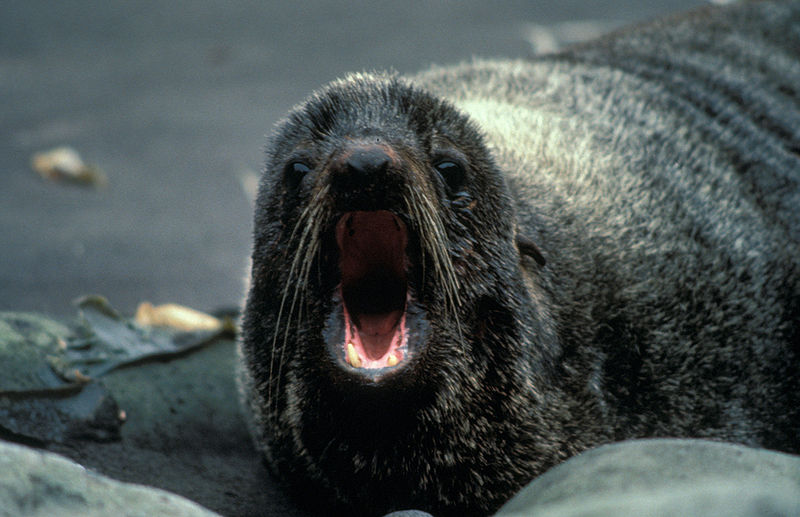|
This blog post was originally published by Columbia Science Review in February 2015. By Alexandra L. DeCandia Humans have a love affair with plastic. Lightweight, versatile, durable, and inexpensive synthetic polymers have flooded the global market since 1950. Yet the qualities that earn success in the marketplace also severely endanger the natural environment. Winds, rivers, and currents ferry lightweight refuse ocean-bound, and cooler temperatures and UV-protection render it long lasting. Plastic floats in bodies of water for decades before degrading into “microplastics,” but even these miniscule particles pose risks to ocean life. They mingle with professional fishing gear and “ghost nets” that wander around the ocean silently seizing marine mammals. Because of these plastics, the limbs of aquatic life get entangled, digestive tracts occluded, and tissues infused with toxins. Entanglement occurs when marine mammals are constricted or entrapped by anthropogenic debris. This may lead to strangulation, open sores, impaired behaviors, increased energy expenditure, and, in extreme cases, drowning. For example, New Zealand fur seals get caught in stray lobster traps but aren’t strong enough to carry them to the surface; thus, they remain trapped. Similarly, Dugongs are unable to wriggle free from the constraints of fishing nets. Even humpback whales, if not freed from tows of nets, ropes, and plastics tangled around their flukes, sometimes die from exhaustion in their struggle to break free. Ocean debris acts as an anchor for these trapped animals. Even stray monofilament lines can lock animals down to the ocean floor, dooming them to death. The second threat stemming from the misuse of plastics, ingestion, occurs when organisms mistake debris for food. Plastics come in all shapes, sizes, and colors, so plastic debris can often mimic the look of mammalian food. Analysis of polar bear scat, for example, revealed ingestion of debris like foil, cardboard, cigarette butts, duct tape, foam rubber, glass, paint chips, paper, plastic, wood, and even a watch band. While these items luckily passed through the animal studied, others often do not. Since synthetic materials do not degrade as organic ones do, ingestion can often yield wounds both internally and externally, gastro-intestinal blockages, false sensations of satiation, toxin bioaccumulation in tissues, impaired feeding capability, and even starvation. In 2008, examination of the stomach contents of two sperm whales stranded in northern California uncovered ropes, plastics, and 134 different types of fishing nets. One whale died of a ruptured stomach; the other of starvation. Both deaths were directly caused by debris ingestion. Marine mammals are fairly diverse, so often times the distinct behaviors, morphologies, and habitat requirements render certain risks more threatening to one type of organism over another. The order Carnivora, which contains polar bears, sea otters, and pinnipeds, dwell at the intersection of land and sea. These animals seem to approach their dual environments with a sense of curiosity. As a result, marine debris poses a particular risk of entanglement as they excitedly explore their surroundings. Pinnipeds are drawn to novel items such as plastic bags or abandoned nets, and often accidentally slip their heads inside loops and holes. Then, since the animal is unable to escape, these “lethal necklaces” remain on the neck of the pinniped, constricting the animal as it grows. For some species, such as the critically endangered Hawaiian monk seal, entanglement has been implicated as a major threat to population growth. Even a seemingly modest rate of entanglement of 0.04%-0.78% has proven detrimental to an ailing population. The order Cetacea consists of mysticetes (baleen whales) and odontocetes (toothed whales). Unlike pinnipeds, cetaceans are entirely marine, large bodied, and migratory. Ingestion is therefore the greatest threat to these animals. Nets and plastics can become tangles at the bottom of the ocean and prevent them from feeding. On a smaller scale, microplastics join the krill that these animals ingest with every gulp or skim of the surface. When the animals filter feed, those synthetic particulates enter their bodies and, in the case of Mediterranean fin whales, leech toxins into their tissues. Odontocetes largely avoid these risks associated with filter feeding. However, their large-scale ingestion of marine debris does cause plastic impaction, gastro-intestinal tract blockages, starvation, and gastric rupture. The final order, Sirenia, contains dugongs and manatees. Like cetaceans, sirenians spend their entire lives submerged beneath the waves of aquatic environments. Unlike cetaceans, they travel through coastal waters, estuaries, and inland river networks. While herbivory minimizes the risk of microplastic bioaccumulation, entanglement and ingestion still pose a threat to these species. When we think about the popularity of plastics in our society, it seems that the threat of entanglement and ingestion is inevitable. However, through the implementation of stringent legislation, recycling initiatives, incentive programs, consumption reductions, and citizen-led clean up efforts, this does not have to be the case. All it takes is education, activism, and compliance on our part. While the ocean can never be completely devoid of plastic, we can prevent further degradation from this point on. Through increased awareness, it is possible that marine mammals won’t have to live in an environment inundated by trash. |
AboutWelcome to the EEBlog! This page links to blog posts DeCandia lab members have written about wildlife conservation & the environment. It also includes posts written for other outreach platforms. Please see linked websites for original versions, when applicable. Archives
February 2021
|

